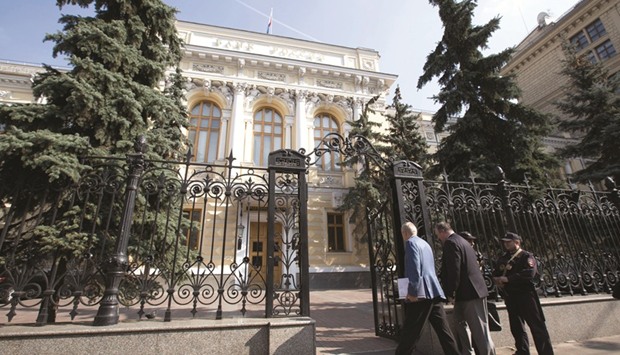Opec has Russia over a barrel when it comes to where its monetary policy goes next.
So much is riding on the outcome of negotiations between the Organisation of Petroleum Exporting Countries and its partners over their output cuts that the Bank of Russia identified it for the first time as “the key source of inflation risks in the near future.” After delivering an unexpected rate cut of half a percentage point on Friday, the future path of monetary policy will detour to Vienna, where Russia and Opec ministers will meet on May 25 to make a final decision.
“It may result in a temporary hike in volatility of capital flows and the exchange rate, undermining exchange-rate and inflation expectations,” the bank said in a statement. “That said, inflation risks will be lower in the scenario with rising oil prices.”
Policy makers are throwing a new degree of uncertainty into their outlook after surprising all but six of 42 economists in a Bloomberg survey with their biggest rate cut since September.
The world’s largest energy exporter is one of 11 non-Opec nations that reached an agreement with the producers’ group last year to cut output by as much as 1.8mn barrels a day in an effort to eliminate a global surplus. The Bank of Russia next reviews borrowing costs on June 16.
“A 50 basis-point cut is a trade-off market measure, buying the central bank more time to see if the oil price goes lower or higher,” said Alexey Pogorelov, an economist at Credit Suisse Group AG.
“Oil is very important. That’s why they added this comment on the oil price as a key threat.”
In March, the central bank’s updated forecasts showed Russia’s Urals export blend at an average of $50 a barrel this year, but falling to $40 at end-2017 and then staying near that level in 2018-2019. Under a more optimistic scenario, it said Urals may average $55 in 2017 and $60 in 2018.
“The next decision will largely depend on the prospects for oil,” said VTB Capital economist Alex Isakov. “That is, the Bank of Russia is linking its decision to oil prices and doesn’t rule out easing.”
Expanding US crude production is threatening to dilute the impact of Opec-led supply cuts. While Russia says it’s on the verge of fully implementing its pledged 300,000 barrel-a-day output reduction, analysts are still debating whether the Kremlin would be willing to join Opec in extending the agreement for another six months.
The Bank of Russia said its “assessment of the overall potential” for easing this year is unchanged. At the previous meeting in March, policy makers cut the benchmark by a quarter- percentage point after a six-month pause.
Gains in the rouble have reduced the value of Russian energy exports, which are denominated in dollars. While crude is 17% higher since November, a barrel of oil in April is giving only about 7% more taxes in roubles than five months ago, Goldman Sachs Group estimates. The price of Brent in roubles last week hit the lowest since last August.
“By flagging the Opec negotiations as clearly as the Russian central bank now did, the bank pre-emptively justifies any rather sudden change to its current path,” said Wolf-Fabian Hungerland, an economist at Berenberg Bank in Hamburg, Germany. “The bank says that the course of its monetary policy is subject to political risk, largely an external one.”

Visitors pass security to enter the headquarters of Russia’s central bank in Moscow. So much is riding on the outcome of negotiations between the Organisation of Petroleum Exporting Countries and its partners over their output cuts that the Bank of Russia identified it for the first time as u201cthe key source of inflation risks in the near future.u201d


